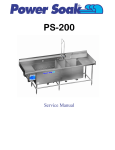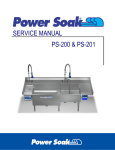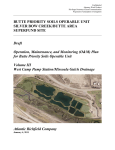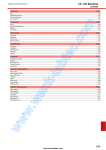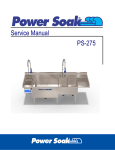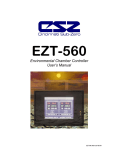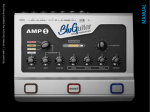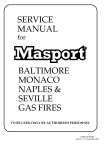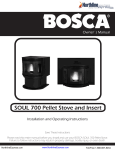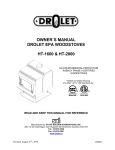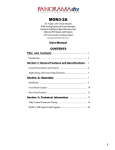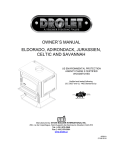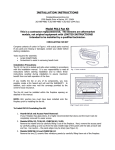Download PS-200
Transcript
Service Manual Revised 5/7/04 Table of Contents Preventive Maintenance Page 2-3 Routine Preventive Maintenance Daily Monthly Notes Troubleshooting Component Operation & Checks Pages 4-6 Pages 7-10 Parts List Pages 11-15 Electrical Schematic Pages 16-19 Pump and Motor Assembly Pages 21-25 Appendix Notes 1 Page 26 Explanation of Warning Messages Be sure to read, understand and follow all DANGER, WARNING, and CAUTION messages located in this guide and on the equipment. Danger Personal Injury and Property Damage hazard. May result in serious injury or death. May cause extensive equipment damage Warning Property Damage Hazard. May result in property or equipment damage. Personal Injury Hazard Hazard from sharp objects. May result in serious injury or death. Chemical Hazard May result in serious injury or death. Instructions, labels and Material Safety Data Sheets (MSDSs) should be supplied with all detergents and sanitizing chemicals. The manufacturers, importers and distributors of your cleaning chemicals are responsible for providing this information. 2 Preventive Maintenance Your system requires minimal, routine preventive maintenance. As such, the following should be done on a routine basis to ensure that your system remains reliable: Daily Clean the liquid level sensors. These sensors are located on the side walls of the wash and sanitizer tanks. They are the white plastic discs with metal centers. Clean the sensor faces thoroughly. If cleaned regularly, a washcloth and soapy water are all that is required. If the liquid level sensors are not cleaned regularly, the machine may fail to operate; or it may be possible to run it without water, which may cause serious damage to the unit. Monthly IMPORTANT: Turn off the power to the unit at the main breaker prior to performing the following task! After shutting off the power at the system’s dedicated breaker, clean the pump motor fan shroud with a stiff bristle brush and a vacuum. If a brush and vacuum are unavailable, clean the shroud with a damp, soapy rag. The motor shroud is the "vented" cover located at the end of the motor (closest to the control panel). This will prevent grease and dust from accumulating in the cover' s openings, which can obstruct the airflow that cools the motor. De-lime the wash sink. Simply add a de-liming agent to a sink of warm, fresh water and run the system overnight. Ask your chemical sales representative to recommend a specific de-liming agent. There are no other preventive maintenance procedures that you will need to perform on your Power Soak system. You need not be concerned about greasing the motor bearings, as they are permanently sealed. If you have any questions regarding the preventive maintenance procedures, please contact the factory at 800-444-9624. 3 Troubleshooting Hazard to untrained or unauthorized personnel. The following procedures are provided for use only by an authorized service agency. No facility owner, manager, employee or other unauthorized person should attempt to perform any of these procedures. To obtain the name of a recommended service agent in your area, please call the Metcraft, Inc. Power Soak Service Department at 800-444-9624. When performing troubleshooting procedures, the authorized service agency will need to open the Power Soak system' s main electrical enclosure. Properly close the control panel before reconnecting the circuits. 4 Troubleshooting PS-200 Pump leaks Look For Correction 1 Defective ADAPTER O-RING replace 2 Defective PUMP SEAL Replace Intermittent running See “Pump does not work” below Pump does not work Look For 1 Slow Flashing Green Light 2 Solid Blue Light Correction Clean Liquid Level Sensors Fill sink with water to proper level Tighten the External Wiring Harness on back of Control Panel Clean Liquid Level Sensors Drain sink and refill with water to proper level 3 Error LED on UPM Record the pattern – See “Error Codes” 4 Red, Green, Blue lights blinking together Low power to UPM – See “No Power” 5 No indicator lights at all Water too hot – reduce temperature to 115°F with ice or cold water See “No Power” Pump works – Heater does not work Look For 1 Water temperature < 110°F Correction 2 Water temperature between 110°F and 120°F Check Heater and replace as necessary Check Triac(s) and replace as necessary Normal operating temperature 3 Water temperature > 120°F Water too hot – reduce temperature to 115°F with ice or cold water Water too hot or not hot enough Look For 1 Water temperature < 110°F 2 Water temperature between 110°F and 120°F 3 Water temperature > 120°F 5 Correction Check Heater and replace as necessary Check Triac(s) and replace as necessary Normal operating temperature Check Thermistor and replace as necessary Too much soap can cause excessive heat buildup Troubleshooting PS-200 No Power Look For Correction 1 Incoming voltage between L1 and L2 (L1-L2) (Also L1-L3, L2-L3 if 3 phase) 2 Less than 10 volts to UPM (leave UPM plugged in during check) Check Heater and replace as necessary Water too hot, above 135°F – empty sink and refill with 115°F water Tighten the External Wiring Harness on back of Control Panel Check transformer and replace as necessary Check thermal cutoff for heater and replace as necessary Check thermal cutoff for motor and replace as necessary Error Codes ~ Represents a “long” flash * Represents a “short” flash Look For 1 2 3 6 ~~~* ~~~** ~~~*** Correction This indicates a Water Level problem. Turn off breaker to sink. Drain sink, clean sensors, refill sink. Turn on breaker to sink. This indicates a Temperature Sensor problem. Tighten the External Wiring Harness on back of Control Panel. Check and replace Thermistor as necessary. This indicates an Over-Current problem. Check and Replace motor and/or heater as necessary. Check and Replace UPM or CT as necessary. Component Operation and Checks The following checks should only be performed by qualified technicians using extreme caution. Electrical hazard to untrained personnel may result in electrical shock, burns, or death. Liquid Level Sensors There are two Liquid Level Sensors (LLS) in the wash sink, and two more in the sanitize sink (if equipped with a sanitize sink). To check operation, first unplug the white connector from the UPM. Measure the resistance between the face of the LLS and the appropriate pin of the white connector. You should read less than one ohm. Refer to the chart below for the appropriate pins. Description UPM pin number Wire color Wash Sink Low LLS Wash Sink High LLS Sanitize Sink Low LLS Sanitize Sink High LLS Pin 19 Pin 20 Pin 21 Pin 22 White with Orange stripe White with Green stripe White with Yellow stripe White with Blue stripe If you read higher than that, you may have a dirty sensor, a broken wire, or a loose connection. The loose connection may be at the sensor on your wiring harness, or the external wiring harness may not be tight at the back of the Control Panel. Thermistor The Thermistor is a temperature sensor. The UPM measures the resistance through the Thermistor, and associates that resistance to a temperature. To check operation, first unplug the white connector from the UPM. Next, measure the resistance across the Thermistor. This reading can be attained at the white UPM connector (reference “UPM” for pin layout), between pin 8 and pin 9. If your reading varies significantly from the Temperature-Resistance chart in Appendix A, the Thermistor may be defective. The UPM will signal an error if it reads a resistance greater than 430 kΩ and less than 15 kΩ. The Thermistor is located close to the Heater, inside the Sensor Pad. When replacing a Thermistor, it is helpful to use a glue dot to hold it in place while reattaching the Sensor Pad to the sink. Also, it is imperative to put heat sink compound on the side of the Thermistor that will be against the sink, and the Heater Thermodisc as well, to help ensure good heat transfer. 7 Component Operation and Checks Heater Thermodisc (Hi-Limit or Cutoff Switch) The Heater Thermodisc is a protection device. If the temperature at the Thermodisc reaches 135°F, the disc opens, cutting off power to the UPM. To check operation, first shut off the circuit breaker to the sink. Next, unplug the connectors P9 and J10 from J9 and P10 for the Motor Thermodisc (reference schematic or “Motor Thermodisc” for location and description). Measure the resistance between J10 and the center-tap of the transformer (reference schematic or “Transformer” for location). Device should read less than one ohm when closed. If you read more than one ohm, the Thermodisc may be defective. Next, check for a short to ground. If you find a short to ground from either side of the Thermodisc, the Thermodisc is either defective, or you may have water in the sensor pad. This condition will keep the UPM from operating correctly. The Thermodisc is located close to the Heater, inside the Sensor Pad. When replacing a Thermodisc it is helpful to use a glue dot to hold it in place while reattaching the Sensor Pad to the sink. Also, it is imperative to put heat sink compound on the side of the Thermodisc that will be against the sink, and the Thermistor as well, to help ensure good heat transfer. Motor Thermodisc (Hi-Limit or Cutoff Switch) The Motor Thermodisc is a protection device. If the temperature at the Thermodisc reaches 180°F, the disc opens, cutting off power to the UPM. To check operation, first shut off the circuit breaker to the sink. Next, unplug the connectors P9 and J10 from J9 and P10 for the Motor Thermodisc (reference schematic for location and description). These connectors plug the two Thermodisc wires (black) to two yellow wires coming out of the internal wiring harness of the Control Panel. Measure the resistance between J9 and P10 (reference schematic, these are the black Thermodisc wires). The device should read less than one ohm when closed. If you read more than one ohm, the Thermodisc may be defective. Next, check for a short to ground. If you find a short to ground from either side of the Thermodisc, the Thermodisc is either defective, or you may have water on the Thermodisc. This condition will keep the UPM from operating correctly. On some of our motors, the Thermodisc is built in to the motor, which is not replaceable. On others, it is located in the wiring box of the Motor, which is replaceable. When replacing, it is imperative to put heat sink compound on the side of the Thermodisc that will be against the motor to help ensure good heat transfer. 8 Component Operation and Checks Transformer The Transformer reduces the incoming power supply voltage to 24 volts, with a 12-volt center-tap. The transformer has acceptable inputs of 120, 240, and 277 volts. It should already be wired to the specifications of Control Panel (refer to schematic). To test the Transformer, first verify the input voltage. This can be done between the L2 terminal and the down-stream/transformer side of the fuse. The fuse holder can be found on the end of the terminal strip. Next, verify the output voltage of the Transformer. You should get 24 volts across it, and 12 volts between the center-tap and each of the other outputs. These voltages can be verified at the three wire nuts on the internal wiring harness near the Transformer. Note the wire colors on the schematic for each wire nut. Triac (Thyristor or Solid-State Relay) The Triac is a three terminal semiconductor for controlling current in either direction. Our use for the Triac is similar to a contactor. When a gate voltage is applied from the UPM (similar to coil voltage on a mechanical Contactor Relay), the Triac conducts (closes) through the power terminals. On a single phase Control Panel, there are two Triacs, one for the Heater, the other for the Motor. Terminals 2 and 3 on each Triac are supplied with incoming voltage. On the top of these Triacs, they are labeled M1 (motor leg 1) and H1 (heater leg 1). On a three phase Control Panel there are four Triacs, two for the Heater, and two for the Motor. Two are labeled identically to a single phase Panel. The two others are labeled M3 (motor leg 3) and H3 (heater leg 3). Terminals 2 and 3 on each Triac are supplied with incoming voltage. To test the Triac, first verify the input voltage to the Triac. An LED on the Triac board signals whether gate voltage has been applied by the UPM. If this light is on, the Triac should be closed, and terminal 1 of the Triac should be supplying power to the respective device. If the LED is off, there should be virtually no current on the output side of the Triac. 9 Component Operation and Checks Contactor If there is 20v-28v across the coil and the contactor does not pull in, the contactor is defective. If there is input voltage across terminals L1 and L2 (also L1-L3 and L2-L3, if three phase) and the contactor is pulled in, but no voltage across terminals T1 and T2 (also T1-T3 and T2-T3, if three phase), the contactor is defective. Heater Element The heater in a PowerSoak sink is rated at 7000 watts. To check operation of the heat element, first turn the power off at the breaker. Disconnect the H2 wire from terminal H2 and the H1 wire from the triac H1 (and H3 wire from H3 triac, if 3 phase) from the Control Panel. Check each heater lead to ground for a short. They all should be open to ground. Check resistance between each of the combinations of the chart below. Connection H1-H2 H1-H2 H2-H3 H1-H3 H1-H2 H1-H2 H2-H3 H1-H3 Heater rated voltage 208-230 208-230 208-230 208-230 460 460 460 460 phase 1 3 3 3 1 3 3 3 Resistance (ohms) 7.56 15.12 15.12 15.12 32.91 65.83 65.83 65.83 The heater should be within about 10% of the value in the chart. If the reading varies significantly from the chart above, the heater may be defective, or there may be a broken wire or loose connection. Electrically, the Heater is three separate elements, each of 2333 watts. When replacing, note how the existing Heater is wired, and refer to the schematic when wiring the new Heater. 10 Parts List Motor – Impeller – Pump Assembly 60 Hz - self-draining HP Side Phase Volt Wet End Motor Impeller 1.5 1.5 1.5 1.5 1.5 1.5 1.5 1.5 2.0 2.0 2.0 2.0 2.0 2.0 2.0 2.0 3.0 3.0 5.0 5.0 5.0 5.0 LH RH LH RH LH RH LH RH LH RH LH RH LH RH LH RH LH/RH LH/RH LH RH LH RH 1 1 1 1 3 3 3 3 1 1 1 1 3 3 3 3 3 3 3 3 3 3 208 208 230 230 208 208 230/460 230/460 208 208 230 230 208 208 230/460 230/460 208 230/460 208 208 230/460 230/460 29600 29601 29602 29603 29604 29605 29606 29607 29608 29609 29610 29611 29612 29613 29614 29615 29616 29617 29618 29619 29620 29621 29506 29506 29500 29500 29508 29508 29502 29502 29507 29507 29501 29501 29509 29509 29503 29503 29510 29504 29511 29511 29505 29505 27590 27591 27590 27591 27590 27591 27590 27591 27592 27593 27592 27593 27592 27593 27592 27593 27594 27594 27596 27597 27596 27597 60 Hz - non self-draining 11 HP side Phase Volt Wet End Motor Impeller 1.5 2.0 2.0 3.0 LH LH LH LH 1 1 3 3 208/230 208/230 230/460 230/460 27548 27554 27558 27566 see above see above see above see above 27590 27592 27592 27594 Parts List Motor – Impeller – Pump Assembly 50 Hz - European HP side Phase Volt Wet End Motor Impeller 1.5 1.5 1.5 1.5 2.0 2.0 3.0 3.0 5.0 5.0 LH RH LH RH LH/RH LH/RH LH RH LH RH 1 1 3 3 1 3 3 3 3 3 220 220 380 380 220 380 380 380 380 380 29622 29623 29624 29625 29626 29627 29628 29629 29630 29631 29512 29512 29514 29514 29513 29515 29516 29516 29517 29517 27592 27593 27592 27593 27594 27594 27488 27489 ? ? Pump Parts Common to all 12 Part # Description 28920 27886 27047 27132 27480 27475 27476 27477 27478 27479 27481 27483 28262 Seal Kit Thermodisc - motor - thermal cutoff Intake gasket Discharge gasket Mechanical Seal "O" ring - sleeve "O" ring - seal plate Key Impeller Bolt Fiber Washer Sleeve Cap Screw - seal plate Dowel Pin Parts List Heater Part # Description 27743 27744 27839 29243 27930 29244 27939 27934 27702 27934 29654 27934 18797 27926 28454 27322 28928 28881 Element - 230 volt - rev. A - ribbon - rear mount Element - 460 volt - rev. A - ribbon - rear mount Gasket for Chromolox heater Element - 208 volt -rev. B - wire - bottom mount - not available yet Element - 230 volt -rev. B - wire - bottom mount Element - 380 volt -rev. B - wire - bottom mount - not available yet Element - 480 volt -rev. B - wire - bottom mount Gasket for Accutherm heater Cover - rev. A - front mount - 17" Cover - rev. B - angle mount - 14" Cover - rev. C - after 02/05/04 - 12" Bolt - heater cover Terminal strip - heater Thermistor - temperature sensor Thermodisc - heater - thermal cutoff Sensor pad Heatsink compound Glue dot 13 Parts List Control Panel Part # 27901 27902 27903 27171 27172 27920 27923 27924 27925 27928 28923 27927 27200 27922 Description Control Panel 220 volt single phase Control Panel 220 volt three phase Control Panel 480 volt three phase Contactor Transformer - 24 volt UPM - Programming Module Terminal Block Grounding Block Din Rail - mount for terminal blocks Triac - solid state relay Fuse Block Heatsink Overlay - start/stop membrane Wiring Harness - internal to control panel Miscellaneous Part # 23987 23988 27847 27848 28065 28066 28669 27854 27854 28553 27855 14 Description Liquid Level Sensor Gasket - Liquid Level sensor Wiring Harness - Wash Wiring Harness - Sanitize Wiring Harness Extension - 3 ft Wiring Harness Extension - 6 ft Utensil Basket Chemical Injector Connector - chemical injector Cap - chemical injector Gasket – Chemical Injector Parts List Optional Chemical Dispenser Dual Pump Chemical Dispenser Part # 28900 28370 29233 29230 29231 29232 29235 29234 28067 29236 29237 29238 29239 29240 29241 29242 28703 28704 103-014 27858 28557 28901 29145 28555 15 Description Chemical Dispenser - Dual Pump - Generic Chemical Dispenser - Dual Pump - Kay Chemical Timer - solidstate Button Guard - metal Switch - MOM - N/O - metal Rectifier - bridge Lock & Key Motor - 24 volt - 120 rpm Wiring Harness - soap dispenser Hook & Loop Screw - #8-32 x 1/2" flat phillips s/s Spring Cone Screw - #10-24 x 1-3/4" pan phillips s/s Pump - 2 cc power wash Tape - double sided foam Key Screw - #6-32 s/s Nut - hex #6-32 s/s Nut Sert - #10-24 tsn Gasket - soap dispenser - PS-200 Overlay - soap dispenser - Kay Chemical Overlay - soap dispenser - generic Terminal Fork 22-18 #8 Insulated Decal - Overlay - Metcraft service PowerSoak ® Electrical Schematic 208-240 volt 60 Hz 1 phase 16 13910 Kessler Drive. Grandview MO. 64030 Systems METCRAFT INC./POWERSOAK® CLAIMS PROPRIETARY RIGHTS IN THE MATERIAL HEREIN DISCLOSED. IT IS SUPPLIED IN CONFIDENCE, WITHOUT PREJUDICE TO ANY PATENT RIGHTS OF METCRAFT INC., AND MAY NOT BE REPRODUCED, SHARED OR USED TO MANUFACTURE ANYTHING SHOWN THEREIN WITHOUT METCRAFT INC.'S WRITTEN PERMISSION. ALL INFORMATION ALWAYS REMAINS THE SOLE PROPERTY OF METCRAFT INC. Power Soak® is a registered trademark of Cantrell Ind., Inc. Licensed by Cantrell Ind., Inc. TITLE Mark C DATE 7/10/2002 DATE REV 1/14/2004 SIZE A SCALE ECR. . NTS #. DWG . DO NOT SCALE DRAWING 27904 SHEET 1 OF 1 REV F PS-200 DRAWN BY PS-200 WIRING DIAGRAM 208/240V 60Hz 1 PH PowerSoak ® Electrical Schematic 208-240 volt 60 Hz 3 phase 17 13910 Kessler Drive. Grandview MO. 64030 Systems METCRAFT INC./POWERSOAK® CLAIMS PROPRIETARY RIGHTS IN THE MATERIAL HEREIN DISCLOSED. IT IS SUPPLIED IN CONFIDENCE, WITHOUT PREJUDICE TO ANY PATENT RIGHTS OF METCRAFT INC., AND MAY NOT BE REPRODUCED, SHARED OR USED TO MANUFACTURE ANYTHING SHOWN THEREIN WITHOUT METCRAFT INC.'S WRITTEN PERMISSION. ALL INFORMATION ALWAYS REMAINS THE SOLE PROPERTY OF METCRAFT INC. Power Soak® is a registered trademark of Cantrell Ind., Inc. Licensed by Cantrell Ind., Inc. DRAWN BY Mark C DATE 7/10/2002 DATE REV 1/14/2004 SIZE A SCALE PS-200 WIRING DIAGRAM 208-240V 60Hz 3 PH ECR. . NTS #. DWG . DO NOT SCALE DRAWING 27905 SHEET 1 OF 1 REV G PS-200 TITLE PowerSoak ® Electrical Schematic 460 volt 60 Hz 3 phase 18 13910 Kessler Drive. Grandview MO. 64030 Systems METCRAFT INC./POWERSOAK® CLAIMS PROPRIETARY RIGHTS IN THE MATERIAL HEREIN DISCLOSED. IT IS SUPPLIED IN CONFIDENCE, WITHOUT PREJUDICE TO ANY PATENT RIGHTS OF METCRAFT INC., AND MAY NOT BE REPRODUCED, SHARED OR USED TO MANUFACTURE ANYTHING SHOWN THEREIN WITHOUT METCRAFT INC.'S WRITTEN PERMISSION. ALL INFORMATION ALWAYS REMAINS THE SOLE PROPERTY OF METCRAFT INC. Power Soak® is a registered trademark of Cantrell Ind., Inc. Licensed by Cantrell Ind., Inc. DRAWN BY Mark C DATE 7/10/2002 DATE REV 1/14/2004 SIZE A SCALE PS-200 WIRING DIAGRAM 460V 60Hz 3 PH ECR. . NTS #. DWG . DO NOT SCALE DRAWING 27906 SHEET 1 OF 1 REV G PS-200 TITLE Electrical Schematic 400 volt 50 Hz 3 phase 19 European 13910 Kessler Drive. Grandview MO. 64030 PowerSoak ® Systems METCRAFT INC./POWERSOAK® CLAIMS PROPRIETARY RIGHTS IN THE MATERIAL HEREIN DISCLOSED. IT IS SUPPLIED IN CONFIDENCE, WITHOUT PREJUDICE TO ANY PATENT RIGHTS OF METCRAFT INC., AND MAY NOT BE REPRODUCED, SHARED OR USED TO MANUFACTURE ANYTHING SHOWN THEREIN WITHOUT METCRAFT INC.'S WRITTEN PERMISSION. ALL INFORMATION ALWAYS REMAINS THE SOLE PROPERTY OF METCRAFT INC. Power Soak® is a registered trademark of Cantrell Ind., Inc. Licensed by Cantrell Ind., Inc. DRAWN BY Mark C DATE 7/10/2002 DATE REV 1/14/2004 SIZE A SCALE PS-200 WIRING DIAGRAM 400V 50Hz 3 PH ECR. . NTS #. DWG . DO NOT SCALE DRAWING 27890 SHEET 1 OF 1 REV F PS-200 TITLE Electrical Schematic 230 volt 50 Hz 3 phase 20 European 13910 Kessler Drive. Grandview MO. 64030 PowerSoak ® Systems TITLE DRAWN BY DATE DATE REV Mark C 7/10/2002 1/14/2004 SIZE A SCALE PS-200 WIRING DIAGRAM 230V 50Hz 1 PH ECR. . NTS #. DWG . DO NOT SCALE DRAWING 27894 SHEET 1 OF 1 REV F PS-200 METCRAFT INC./POWERSOAK® CLAIMS PROPRIETARY RIGHTS IN THE MATERIAL HEREIN DISCLOSED. IT IS SUPPLIED IN CONFIDENCE, WITHOUT PREJUDICE TO ANY PATENT RIGHTS OF METCRAFT INC., AND MAY NOT BE REPRODUCED, SHARED OR USED TO MANUFACTURE ANYTHING SHOWN THEREIN WITHOUT METCRAFT INC.'S WRITTEN PERMISSION. ALL INFORMATION ALWAYS REMAINS THE SOLE PROPERTY OF METCRAFT INC. Power Soak® is a registered trademark of Cantrell Ind., Inc. Licensed by Cantrell Ind., Inc. Motor and Pump Assembly Exploded view 1 3 9 6 5 4 7 10 8 2 14 15 16 11 Item 1 2 3 4 5 6 7 8 * * * 12 13 Description Casing Cotter pin – part of casing Stud – part of casing Impeller screw - 9/16” hex Impeller washer Impeller Impeller key Sleeve O-ring Item 9 10 11 12 13 14 15 16 * * * Indicates parts included in the seal kit 21 Description Shaft Sleeve Mechanical Seal Adapter O-ring Motor bolt – 5/16” allen Adapter plate Washer Casing Nut – 9/16” hex Motor Motor and Pump Assembly Disassembly Procedure 1. Remove casing nuts (15), which hold adapter (13) to casing (1). 2. Pry adapter (13) from casing (1) with pry bar or large screwdriver and remove adapter (13) and motor (16) from casing (1). 3. Using a suitable holder to keep impeller (6) from turning, remove impeller cap screw (4) and washer (5). Be careful not to damage precision surfaces of impeller (6). 4. Remove impeller (6) and impeller key(7) from shaft. 5. With impeller (6) and key (7) removed, the shaft sleeve (9) and the mechanical seal(10) can be removed as a unit. Sometimes, the sleeve is difficult to remove due to rust from moisture accumulation. If this is the case, applying heat to the sleeve exterior with a torch and/or a gear puller may help. The heat allows the sleeve to expand. However, too much heat may allow the shaft to expand as well. 6. Remove adapter screws (12), which hold adapter (13) to motor (16). 7. Remove adapter (13) from motor (16) by prying with pry bar or screwdriver. 22 Motor and Pump Assembly Inspection and Repair of Components With pump wet-end disassembled, clean all parts and check for worn or damaged areas. It is seldom economical on these pumps to repair damaged or worn parts. Therefore, when a part is found unusable, it should be replaced. Casing Clean and inspect gasket surfaces for damaged areas that would cause leaks. Check wearing ring surfaces for excessive wear. Impeller Check wearing ring surfaces for excess wear and gasket surfaces of impeller hub for damage. If excessively worn or eroded, the impeller should be replaced. Adapter Clean and inspect gasket surfaces. Remove any dirt or scale from mechanical seal cavity. Check adapter ring for wear and excess clearance. Shaft Sleeve Check for any damage to gasket surface on impeller end, O-ring groove on motor end, or outside diameter where rubber bellow of mechanical seal contacts. Mechanical Seal It is not recommended that the mechanical seal be reused unless the pump has never been run. A mechanical seal is like a gasket in this respect. Using an old one leaves too much chance of failure to make the gamble worthwhile, considering the usual cost of installing and removing a pump from its system. Motor or Frame Shaft Check the shaft for any bent condition by installing the shaft sleeve, clamping a dial indicator to the motor face and reading runout at center of sleeve while turning shaft by hand. Maximum allowable runout is .002 inches for proper performance of mechanical seal. Anything beyond this will require repairs to the motor, which are beyond the scope of these instructions. Check motor fan and shroud for damage and clean, if necessary. 23 Motor and Pump Assembly Assembly Procedure The PowerSoak pumps are easy to put together. The hardest part, requiring the most care, is installation of the mechanical seal parts. Study the exploded diagram and become familiar with the name of each part. The diagram shows the relative order of assembly, but also READ THE FOLLOWING INSTRUCTIONS. 1. Make sure all of the parts are clean and ready for assembly. This means no dirt or pieces of old gasket in the joints between the motor, adapter, and casing. Make sure the parts around mechanical seal are clean. Dirt and misalignment will ruin a mechanical seal. 2. Install the shaft sleeve o-ring in the place against the motor shaft shoulder. Don’t let it be cut by the sharp edges of the keyway. 3. Push the mechanical seal seat squarely in the adapter. Use fingers only. A little liquid soap (or light oil if soap not available) can be wiped on the outside of the seat ring to make it slip easily into position. Don’t let it be cut by the edges of the adapter. Don’t install the adapter on the motor face yet. 4. Check the shaft sleeve fit on the motor shaft. It should slide easily into place. If it doesn’t, find out why. Do not try to drive the shaft sleeve onto the shaft with a hammer. Check to make sure there are no score marks or scratches on the sleeve. 5. Install the adapter and tighten the cap screws, which hold tit to the motor face. 6. Remove any dirt particles and coat the lapped face of the mechanical seal with clean SAE 10 or SAE 20 oil. DO NOT USE GREASE. 7. Slide the shaft sleeve on the shaft so that it covers the shaft sleeve o-ring and butts against the shoulder. 8. Coat the shaft sleeve lightly with liquid soap (or light oil if soap not available). 9. Carefully remove any particles from the lapped face of the carbon washer (part of the mechanical seal) and coat it with clean SAE 10 or SAE 20 oil. DO NOT USE GREASE. 24 Motor and Pump Assembly Assembly Procedure - Continued 10. Install the mechanical seal on the shaft sleeve by hand. A twisting motion may be needed to make it ride smoothly over the shoulders on the sleeve. Push it by hand until it contacts the seat; make sure the spring and spring holder line up properly. *(See note) 11. Install the snap ring using one hand to hold the snap ring pliers and the other hand to compress the spring. When the spring pressure is released, the spring will push the shaft sleeve outward, exposing the shaft sleeve o-ring to view temporarily. 12. Install the impeller key, first twisting the shaft sleeve on the shaft until the keyways line up. 13. Install the shaft sleeve gasket. 14. Place the impeller on the shaft engaging the key. 15. Put the impeller screw gasket, impeller washer, and impeller washer gasket together on the impeller screw as an assembly. 16. Install the impeller screw subassemblies. With one hand, push the impeller back against the mechanical seal spring and with the other hand turn the impeller screw in hand tight. 17. Check to see if the shaft sleeve has moved to its final position covering most of the shaft sleeve o-ring. 18. Tighten the impeller screw to 15 ft-lb. torque. 19. Install the casing gasket on the shoulder of the adapter. 20. Install the casing and tighten all the casing screws. 21. Turn the motor shaft and check for any bindings or rubs caused by such things as damaged or mis-aligned parts. Re-check all casing bolts for tightness. Tighten casing bolts one at a time, turning the motor shaft, until rub disappears. *NOTE An optional procedure for assembly of the mechanical seal consists of mounting the mechanical seal and the snap ring on the sleeve as a subassembly, which is then placed in position on the motor shaft. Experienced pump mechanics may find that this is more convenient as long as they recognize that this way introduces some additional hazards of damaging or improper assembly of precision seal parts. 25 Appendix A 150 140 130 120 110 100 90 80 70 60 50 40 30 20 95 10 0 10 5 11 0 11 5 12 0 12 5 13 0 13 5 14 0 14 5 85 90 75 80 65 70 Resistance (K ohms) Thermistor Resistance-Temperature Chart Temperature (degrees Fahrenheit) 26 Notes ______________________________________________ ______________________________________________ ______________________________________________ ______________________________________________ ______________________________________________ ______________________________________________ ______________________________________________ ______________________________________________ ______________________________________________ ______________________________________________ ______________________________________________ ______________________________________________ ______________________________________________ ______________________________________________ ______________________________________________ ______________________________________________ ______________________________________________ ______________________________________________ ______________________________________________ ______________________________________________ ______________________________________________ ______________________________________________ ______________________________________________ ______________________________________________ ______________________________________________ ______________________________________________ 27 Notes ______________________________________________ ______________________________________________ ______________________________________________ ______________________________________________ ______________________________________________ ______________________________________________ ______________________________________________ ______________________________________________ ______________________________________________ ______________________________________________ ______________________________________________ ______________________________________________ ______________________________________________ ______________________________________________ ______________________________________________ ______________________________________________ ______________________________________________ ______________________________________________ ______________________________________________ ______________________________________________ ______________________________________________ ______________________________________________ ______________________________________________ ______________________________________________ ______________________________________________ ______________________________________________ 28 Power Soak is a registered trademark of Cantrell Industries, Inc. The Power Soak design and concept is fully patented. 13910 Kessler Drive, Grandview, MO 64030 Phone: (816) 761-3250 Fax: (816) 761-0544 (800) 444-9624 www.powersoak.com 29






























